Scottish Health Survey 2014 - volume 1: main report
Presents results for the Scottish Health Survey 2014, providing information on the health and factors relating to health of people living in Scotland.
This document is part of a collection
9 INEQUALITIES IN HEALTH RISKS
Linsay Gray & Alastair H Leyland
SUMMARY
Alcohol consumption
- Men and women's weekly alcohol consumption has declined over time for all deprivation groups, with no apparent change in the social patterning.
- In each year from 2008 onwards women in the least deprived areas have been between seven and nine percentage points more likely to drink at hazardous / harmful levels than those in the most deprived areas. Those in the least deprived areas have also consumed more units per week in each year of the survey, than women in the most deprived areas.
- The pattern for men in terms of drinking at hazardous / harmful levels and area deprivation was not clear.
Smoking
- Although overall smoking rates have declined since 2003, prevalence remains around 3 to 4 times higher among men and women in the most deprived areas, compared with those in the least.
- Smokers living in the most deprived areas smoked more cigarettes per day than smokers in the least deprived areas (roughly 3-5 cigarettes per day more in each year of the survey); and, while the total volume of cigarettes consumed has declined, this gap remains for male and female smokers.
- For current smokers, both the desire to quit and number of quit attempts made were not associated with area deprivation.
Adult eating habits
- Fruit and vegetable consumption was lower among adults living in the most deprived areas, and steadily increased as deprivation declined.
- The difference between the proportion eating five or more portions a day in the most and least deprived areas has not changed over time for women, but it has decreased among men.
- Adults' consumption of sweets, chocolates or biscuits once a day or more did not vary by area deprivation.
- Adults in the least deprived areas were more likely than those in the most to eat white fish (58% in least, 49% in most) and oily fish (33% least, 18% most) at least once a week, high fibre / low sugar cereal most days of the week (38% least, 24% most), and drink low-fat milk (81% least, 66% most).
- Adults in the most deprived areas were more likely than those in the least to eat processed meat products (17% least, 37% most) and chips (22% least, 40% most) twice a week or more, and to drink non-diet soft drinks at least once a day (19% least, 37% most).
Child eating habits
- Fruit and vegetable consumption was lower among children living in the most deprived areas, and steadily increased as deprivation declined.
- The difference between the proportion eating five or more portions a day in the most and least deprived areas has not changed over time for children.
- In 2012/2013/2014, children in the least deprived areas were more likely than those in the most to eat white fish (57% in least, 49% in most) and oily fish (23% least, 11% most) at least once a week, high fibre / low sugar cereal most days of the week (35% least, 23% most), 5-6 slices of high fibre bread per day (39% least, 24% most), potatoes, pasta and rice most days of the week (62% least, 45% most), and drink low-fat milk (65% least, 48% most). Boys in the least deprived areas were more likely than those in the most to eat cakes at least twice weekly (44% least, 26% most).
- Children in the most deprived areas were more likely than those in the least to eat meat products (50% most, 29% least) and chips (49% most, 28% least) twice a week or more, and to consume sweets / chocolates (58% most, 42% least) or non-diet soft drinks (45% most, 30% least) at least daily.
Child physical activity
- There was no overall association between area deprivation and the proportion of children aged 2-15 meeting the recommendation to be active for at least an hour every day.
- In contrast, the proportion of children in the most deprived areas that had participated in sport in the past week was at least 10 percentage points lower in most years than the proportion in the least deprived areas.
- This inequality in sports participation has increased significantly over time due to declining levels among those in the most deprived areas.
Adult physical activity
- Adherence to the physical activity guideline for adults declined steadily as deprivation increased, from 70% among adults in the least deprived quintile to 54% among those in the most deprived quintile.
Adult BMI, overweight and obesity
- In most years, the prevalence of obesity was at least 10 percentage points higher for adults in the most deprived quintile than in the least.
- The prevalence of overweight including obesity was higher among women in the most deprived quintile than the least deprived quintile, but the reverse tended to be true among men.
- While levels of BMI and obesity increased between 2003 and 2008 and then plateaued, its social patterning did not change significantly in the 2003-2014 period.
Child obesity
- In every year since 1998, children living in the least deprived areas had the lowest levels of obesity risk (BMI at or above the 95th centile) and, from 2009 onwards, those in the most or 2nd most deprived areas had the highest risk (difference of 9-14 percentage points).
- Children's risk of being overweight (but not obese) was unrelated to area deprivation, and has not changed over time.
9.1 INTRODUCTION
Health inequalities are the systematic differences in life expectancy and physical and mental health among groups of people occupying unequal positions in society.[1] These differences are essentially seen for health and its associated risks and behaviours in all societies.[2] Groups can be defined according to characteristics such as gender, ethnicity and, most fundamentally,[3] socio-economic position - whereby those who have the least access to resources such as income and education experience the highest levels of preventable illness.[4] There are typically gradients in health and associated risk factors by socio-economic status, such that successively more advantaged groups have incrementally better health and longer life expectancy relative to the less advantaged.2 The focus of this chapter is socio-economic inequalities in health risks, by area deprivation specifically.
9.1.1 Policy background
Since inequalities in health are seen to be key and have been increasing over time,[5] reducing them is a major cause for concern and of considerable importance in Scotland.[1]1
While health in Scotland has steadily improved for most people over the last 50 years,[6],[7] it has not been progressing quickly enough among the most vulnerable groups in society[2]2 and entrenched inequalities remain.[7],[8] The Scottish Government has committed to identifying the means to reducing health inequalities and their causes.[9] In its Report on Health Inequalities published at the beginning of 2015, the Scottish Parliament Health and Sport Committee pledged to widen the debate on health inequalities, facilitate policy development and review government action to reduce them.[10] This builds on previous recognition by a Ministerial Task Force on Health Inequalities of the need to monitor[11] and facilitate[12] progress in tackling health inequalities in the longer as well as short and medium term. The Task Force's first report, Equally Well,[13] established the Scottish Government's approach to monitoring and tackling inequalities in health. Its most recent report[14] incorporated NHS Health Scotland's policy review[15] of interventions to address inequalities, which emphasised the importance of actions to address the broader social and economic determinants of inequality, rather than solely focusing on NHS-based solutions. More recently, a Health Inequalities Action Group has been established to oversee delivery of actions to reduce health inequalities. These actions are based on those developed earlier by the Task Force, namely: the development of social capital; increasing the capacity of community planning partnerships to take the lead in addressing health inequality; a specific focus on the 15-44 age group; and the development of a Place Standard to improve people's living environments.[14]
Scotland's current national priorities are set out in the National Performance Framework of Scotland Performs. A healthier Scotland[16] brought about by improving opportunity and reducing inequalities is one of five strategic objectives underpinning its core purpose to 'create a more successful country'.[17] The Glasgow Centre for Population Health has called for rigorous approaches to the planning, monitoring and evaluation of action on health inequalities.[18]
9.1.2 Reporting of area-based inequalities in health risks in the Scottish Health Survey (SHeS)
This chapter considers key risks to health and their patterning by area deprivation, separately for each sex, for the current and previous survey years among adults and, importantly, children in Scotland[19] building on work conducted elsewhere.[20] For adults, the health risks covered here include alcohol consumption; cigarette smoking (including quit attempts); fruit and vegetable consumption, high-sugar processed foods and other eating habits; physical activity; and BMI. Trends in children's area-based health risks are presented for fruit and vegetable consumption; physical activity; and BMI. A summary of children's eating habits by area deprivation is also presented using combined data from the 2012, 2013 and 2014 surveys.
9.2 METHODS AND DEFINITIONS
9.2.1 Measuring health risks
Weekly alcohol consumption
Participants (aged 16 and over)[21] who reported that they drank alcohol were asked how often during the past 12 months they had drunk each of a range of different types of alcoholic drink, and how much of it they had drunk on each occasion. These data were used to estimate the average number of units consumed per week. The alcohol time series goes back to 2003. See Chapter 2 on alcohol consumption for further details.
Current smoking status and quit attempts
Questions on adult smoking behaviour have been included in the survey since 1995. Information is collected about cigarette smoking,[22] including the number smoked per day (for adults aged 16 and over), as well as about quit attempts and smokers' desire to quit (aged 18 and over).[23] See Chapter 3 on Smoking for more details on the smoking status classification presented in this chapter.
Measures of eating habits
Two different sets of questions were used to assess eating habits in the survey. The first assessed fruit and vegetable consumption, and was designed to monitor the 5-a-day policy. This set has been asked of all adults and children aged 5 and over since 2003 (and children aged 2 and over annually since 2008). The second set, gathering information on a wider range of eating habits, including high sugar foods, has been asked of children every year since 2008, and a sub-sample of adults biennially (2008, 2010, 2012 and 2014).[24] See Chapter 4 on Diet for further details on classifications.
Physical activity
The questions on child physical activity, included in SHeS since 1998, cover: sports and exercise; active play; walking; and housework or gardening (children aged 8 and over only). The adult physical activity questionnaire covers the same topics as the child questionnaire (apart from active play), however, changes made in 2003 and 2012 make comparable trend analysis more difficult to conduct. This chapter therefore presents trend data for children (1998-2014) and adult data just for 2014. Both sets of data are used to estimate adherence to government recommendations on physical activity. See Chapter 5 on physical activity for further details on classifications.
Body Mass Index (BMI)
The Body Mass Index (BMI), defined as weight (kg)/height squared (m2), is a widely used measure that allows for differences in weight due to height. BMI was calculated for all participants aged 2 and over for whom a valid height and weight measurement was recorded. See Chapter 6 on obesity for further details on classifications.
9.2.2 Scottish Index of Multiple Deprivation (SIMD)
The Scottish Index of Multiple Deprivation (SIMD) is used within this report as the primary area-based deprivation measure. The Scottish Index of Multiple Deprivation identifies small area concentrations of multiple deprivation across all of Scotland in a consistent way and comprises of a single index based on 38 separate indicators across seven different domains: employment; income; health; education, skills and training; geographic access to services; crime; and housing. Each one of 6,505 small areas - known as data zones - comprising the whole of Scotland are then ranked according to their respective levels of deprivation from the most deprived (rank of 1) to the least deprived (rank of 6,505).
9.2.3 Analysis approach
Analysis using SIMD needs careful consideration.[25] As data zones are ranked, the SIMD therefore provides a relative rather than an absolute measure of deprivation. In addition, it is not possible to analyse the absolute changes in SIMD over time[26] (with the exception of the Employment domain and a small number of individual indicators within some domains) due to changes in calculations over time although the relative change for data zones can be examined for all domains and indicators.
This report uses deprivation quintiles which are obtained by splitting the ranking of the Scotland level data zones into five quintiles with approximately 20% of the all-ages population in each. The SIMD releases in 2004, 2009v2 and 2012 were used for data from the surveys conducted in 1995, 1998 and 2003; 2008 and 2009; and 2010, 2011, 2012, 2013, 2014, respectively as per recommendations.
Age standardisation (see glossary) of results for adults has been done using 2013 population estimates for all survey years, to allow comparisons between years that are not affected by changes in the age profile of deprivation quintiles. Figures for previous years may therefore differ from those previously published. Results for children were not age-standardised.
Analysis was conducted on a pooled sample of data from all relevant survey years. Three key analyses were conducted for each of the tables produced. Firstly, the significance of the association between SIMD and the outcome of interest was assessed overall for the whole period in question. Secondly, the statistical significance of any trend over time was ascertained, for all adults or children, and for men / women separately. Finally, the extent to which any trends identified differed across the deprivation quintiles was assessed by examining the statistical significance of the association between the year and deprivation interaction and the outcome in question. This helped shape conclusions about the nature of inequalities in health risks over time.
9.3 ALCOHOL CONSUMPTION
9.3.1 Hazardous / harmful drinking
The proportions of men drinking hazardous / harmful weekly amounts of alcohol significantly differed by SIMD during 2003 to 2014. However, differences were generally small, and a consistent pattern was not obvious. Although drinking at hazardous / harmful levels significantly declined over time overall among all men in the population, the rate of decline did not vary significantly by deprivation quintile.
The patterns among women were much clearer. In every year, a significantly higher proportion of women in the least deprived areas drank at hazardous / harmful levels compared with the most deprived areas. At its peak, in 2003, the difference in hazardous / harmful drinking prevalence between women in the least and most deprived quintiles was as much as 14 percentage points, though this narrowed somewhat and ranged between 7 and 9 percentage points in all other years. The differences by area deprivation did not vary significantly over time although the overall proportions did significantly decrease over time.
9.3.2 Mean unit consumption
From 2008 to 2012 men living in the most deprived quintile tended to consume higher total units of alcohol per week compared with those living in the two least deprived quintiles, although this was not the case in the earlier or most recent years. In contrast, and in line with women's patterns for hazardous / harmful drinking, women living in less deprived areas consumed higher total units of alcohol per week than those living in more deprived areas. The amounts declined over time for both sexes and this was generally true regardless of area deprivation. Table 9.1
9.4 SMOKING
9.4.1 Cigarette smoking
The social inequalities in smoking prevalence have been stark in the 2003 to 2014 period, for both men and women. Current smoking was heavily socially patterned, with prevalence among men living in the most deprived areas being around 2.5 to 4 times higher than in the least deprived areas. The picture is the same for women, with those in the most deprived areas being around 3 to 4 times as likely to smoke as those in the least deprived areas, throughout this time period. As Figures 9A and 9B illustrate, smoking has significantly declined over time but with no sign that the gap between the most and least deprived has changed significantly over time.
Further to smoking being much more prevalent among adults living in deprived areas, smokers living in the most deprived areas smoke significantly more cigarettes than smokers living in the least deprived areas (a difference of between roughly 3 and 5 cigarettes per day in each year of the survey). The number of cigarettes smoked has decreased significantly over the period 2003 to 2014 but this social patterning has persisted. This was true for male and female smokers alike. Figure 9A, Figure 9B, Table 9.2
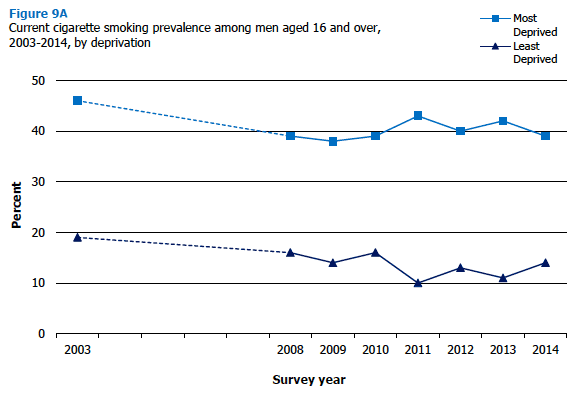
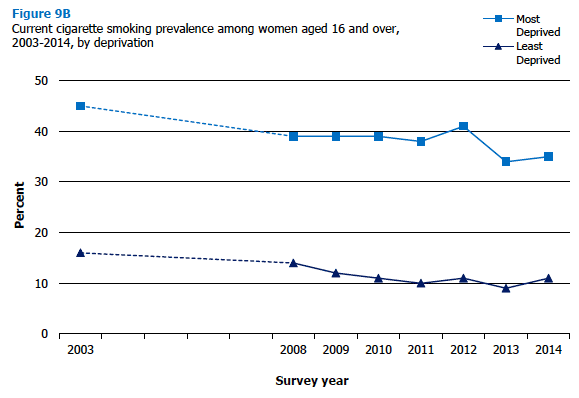
9.4.2 Quit attempts and aspirations
The number of unsuccessful[27] quit attempts reported by smokers did not vary significantly overall by area deprivation, nor over time during 2003 to 2014. This was the case for both men and women, though prevalence of smoking is much lower in the least deprived areas, so the sample sizes for smokers in these areas are quite small.
The proportions of male and female smokers who would like to quit did not vary significantly by area deprivation during the time period. Looking at the whole population, the overall proportion of male smokers who would like to quit declined during 2003 to 2014, indicating a more persistent population of smokers as overall smoking prevalence has declined (see Table 9.2). The proportion did not vary significantly for female smokers. Table 9.3
9.5 EATING HABITS
9.5.1 Trends in fruit and vegetable consumption since 2003
Adults
For both men and women, consumption of five or more portions of fruit and vegetables per day was patterned by area deprivation, with the proportion meeting this recommendation increasing as deprivation decreased. Across the whole population, consumption of five or more portions of fruit and vegetables per day did not vary by year for men but increased and then declined slightly for women. There was a significant change over time in the patterning by area deprivation of men's consumption, with the gap between the most deprived and the least deprived narrowing over time (due mainly to consumption increasing somewhat among men living in the most deprived areas). The gap for women, on the other hand, remained.
In each year, the mean number of fruit and vegetable portions consumed was significantly lower for individuals living in more deprived areas than those living in less deprived areas (with a steady decline apparent between each quintile); this held for both men and women. The mean number of portions consumed by women varied significantly over time (with a small increase followed by a decline from 2009 onwards - see Table 4.1) but did not vary significantly for men. There were no significant changes over time in the area deprivation inequalities in mean portions consumed. Figure 9C, Figure 9D, Table 9.4
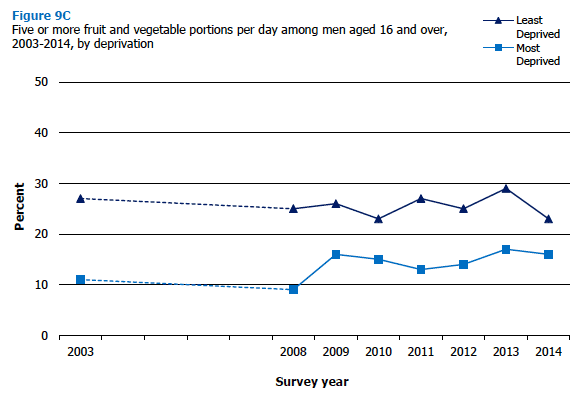
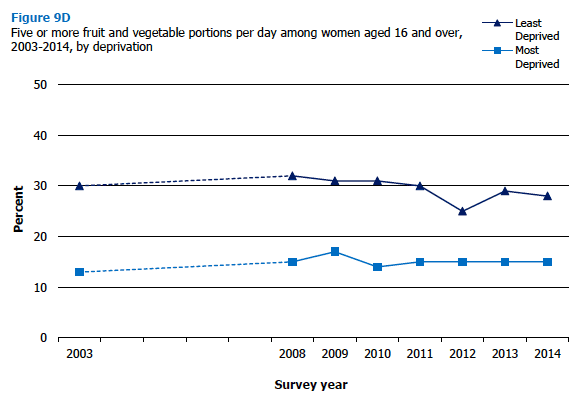
Children
For the period 2003 to 2014 as a whole, the proportion of children aged 5-15 consuming five portions or more of fruit and vegetables was significantly lower among those living in the most deprived areas compared with those living in the least deprived areas. This was generally the case for each individual year. Although the proportion of all children in each period eating five or more portions per day fluctuated over time across all quintiles these differences were not statistically significant.
The mean fruit and vegetable portions consumed was significantly lower among children living in the most deprived areas compared with those from the least deprived areas, with no change in this pattern evident over time. There was no significant change over time in consumption in the whole population. Table 9.5
9.5.2 Trends in adult high-sugar processed food consumption since 2008
This section reports trends in the social patterning of high-sugar processed food consumption. The following section (9.5.3) covers a wider range of food types, but does not include trends.
Sweets or chocolates
Adults' consumption of sweets or chocolates once a day or more did not vary significantly by area deprivation for either men or women during 2008 to 2014. Looking at the whole population, there was significant variation in consumption levels over time among women but with no discernible pattern.
Biscuits
As for sweets or chocolates, the consumption of biscuits once a day or more among adults during 2008 to 2014 did not vary by area deprivation. There was a significant decrease in at least daily biscuit consumption over time among women overall, but with no apparent change to its social pattering.
Non-diet soft drinks
The proportion of adults consuming non-diet soft drinks once a day or more during 2008 to 2014 was significantly higher among those living in the most deprived areas than the least. For example, among men, non-diet soft drink consumption was consistently more than 1.5 times higher in the most deprived areas compared to the least. There were no changes in these inequalities over time for men. The disparities in consumption of non-diet soft drinks once a day or more generally widened between 2008 and 2014 for women, although not significantly so. Table 9.6
9.5.3 Adult eating habits in 2014, by SIMD
This section reports some additional adult eating habits data by SIMD and sex. As noted in Section 9.2.3, the figures reported in Table 9.7 have been age-standardised.
Meat and fish
Figure 9E and Table 9.7 show that the age-standardised prevalence of white fish, oily fish and meat product consumption all varied according to levels of area deprivation in 2014. White fish and oily fish were consumed more frequently by people in less deprived areas than those in more deprived areas, while the reverse was true for the consumption of meat products. One third of adults (33%) in the least deprived areas ate oily fish at least once a week, declining to one sixth (18%) in the most deprived areas, with a similar pattern for white fish (58% in least, 49% in most). In contrast, one sixth of adults (17%) in the least deprived areas ate meat products more than once a week, compared with more than double that proportion (37%) in the most deprived areas. There was less of a clear pattern for red meat with 48% in the most deprived areas eating it twice or more a week and 54-61% in the other, less deprived areas. Figure 9E, Table 9.7
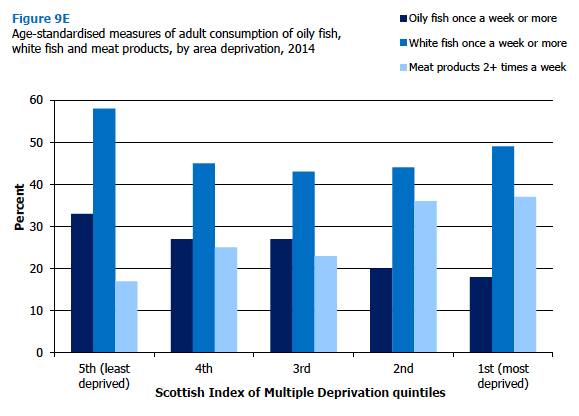
Milk
A greater proportion of adults living in the least deprived areas, in 2014, consumed skimmed or semi-skimmed milk than those living in the most deprived areas (81% and 66% respectively, using age-standardised measures). Table 9.7
Foods rich in starch and fibre
People living in the least deprived areas were more likely to consume high-fibre, low sugar cereal than those in the two most deprived quintiles (38% and 24%, respectively, age-standardised prevalence). Eating 2-3 slices of high fibre bread daily showed a similar pattern (47% did this in the least deprived areas compared with 34-35% in the two most deprived quintiles). Table 9.7
Foods and drinks high in fat and / or sugar
Age-standardised measures of the consumption of the sugary foods mentioned above (sweets, biscuits, cakes and ice-cream) did not vary significantly with levels of area deprivation in 2014 (section 9.5.2 illustrated that this has not changed over time). However, the age-standardised prevalence of daily consumption of non-diet soft drinks increased with higher levels of area deprivation, almost doubling from 19% in the least deprived areas to 37% in the most deprived.
A similar pattern was observed for the age-standardised prevalence of the consumption of chips at least twice a week, increasing from 22% in the least deprived areas to 40% in the most deprived.
Patterns of the daily consumption of crisps differed for men and women. Age-standardised measures of crisp consumption showed that women in the two most deprived quintiles were more likely to eat crisps daily than those in the other three quintiles (25-27%, compared with 13‑15%). Figures for men living in the two most deprived quintiles, however, were similar to those for men living in the two least deprived quintiles (all between 23% and 26%). Table 9.7
9.5.4 Child eating habits in 2012/2013/2014, by SIMD
Table 9.8 presents eating habits by area deprivation for children aged 2-15 for the same food items shown in Table 9.7 for adults. To increase the precision of the results, data from the 2012, 2013 and 2014 surveys have been combined.
Meat and fish
Consumption of oily fish at least once a week declined as deprivation increased, from 23% for children in the least deprived quintile to 11% for those in the two most deprived quintiles. Levels of at least weekly white fish consumption were much higher overall, but also declined with deprivation, from 57% in the two least deprived quintiles to 48-49% in the two most deprived. In contrast, tuna fish consumption did not vary significantly by area deprivation. Consumption of meat products at least twice weekly increased steadily across each deprivation quintile, from 29% of children in the least deprived areas to 50% of those in the most deprived areas. Red meat consumption was similar across all deprivation quintiles. While these overall patterns were generally the same for boys and girls separately, the patterns for meat products diverged a little. Boys' consumption of meat products increased steadily with deprivation across each quintile before stabilising at 51-52% in the two most deprived quintiles. In contrast, girls' consumption levels were similar in the three least deprived quintiles (24-27%) before increasing to 38% and 48% in the second and first most deprived quintiles, respectively.
Milk
Drinking low-fat milk declined steadily as area deprivation increased, from 65% for children in the least deprived areas to 48% for those in the most, with similar patterns for boys and girls.
Foods rich in starch and fibre
The proportion of children eating 2-3 slices of high fibre bread daily almost halved between the least and most deprived areas (from 39% to 24%, respectively). High fibre / low sugar cereal consumption followed a very similar pattern, with 35% of children in the least deprived areas eating this 5-6 times a week compared with 23% of those in the two most deprived quintiles. These patterns were true for boys and girls, though boys tended to be more likely than girls to eat these types of food. Consumption of potatoes, pasta or rice at least five times a week declined steadily as deprivation increased, from 62% in the least deprived quintile to 45% in the most, with same level of decline seen for both boys and girls.
Foods and drinks high in fat and / or sugar
Daily consumption of sweets / chocolates increased with increasing levels of deprivation, from 42% in the least deprived quintile to 58% in the most deprived quintile. Daily consumption of non-diet soft drinks also increased with area deprivation, from 30% for children in the least deprived quintile to 44-45% in the two most deprived quintiles. The patterns for boys and girls were very similar. Eating cakes at least twice a week was more common among children in the least deprived quintile (39%) than in the two most deprived quintiles (26-28%). However, this pattern was largely accounted for by boy's cake consumption patterns: 44% of boys in the least deprived quintile ate cakes at least twice a week compared with 26-28% in the two most deprived quintiles, whereas the figures for girls fluctuated with no clear pattern. The other high sugar products in Table 9.8 (biscuits and ice cream) did not vary by deprivation.
Eating chips at least twice weekly increased across the deprivation quintiles, from 28% in the least deprived areas to 49% in the two most deprived. Daily crisp consumption followed a very similar pattern, increasing from 27% in the least deprived quintile to 47% in the most. The separate patterns for boys and girls were very similar. Table 9.8
9.6 PHYSICAL ACTIVITY
9.6.1 Child physical activity
Taking the period 1998 to 2014 as a whole, there was no significant association between level of area deprivation and the proportion of children meeting the physical activity guideline of at least 60 minutes' activity on every day of the week using the measure that excludes activity at school (the same was true for the more recent data including school activity). There was an increase in activity levels over time from 2008 (including school-based activities) that varied significantly by area deprivation, with the greatest increase seen among children living in the middle (third most deprived) quintile.
9.6.2 Child sport participation in the last week
Across 1998 to 2014 as a whole, sport participation in the last week was more common among children living in the least deprived areas compared to those living the most deprived areas. There was a significant decline over time in sport participation among children, with the decline most apparent in the three most deprived quintiles. This widening of inequalities in children's sports participation by SIMD is illustrated in Figure 9F. Figure 9F, Table 9.9
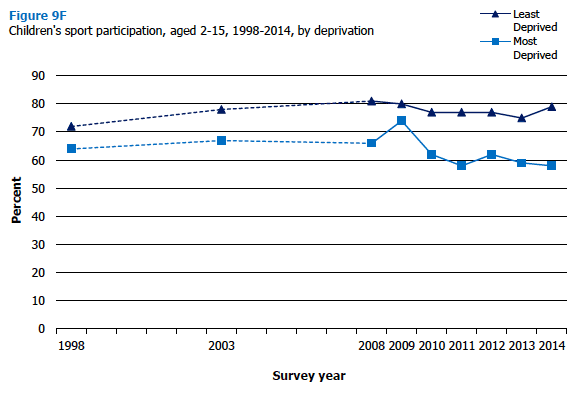
9.6.3 Adult summary physical activity levels, and adherence to the aerobic activity guideline in 2014
As noted in Section 9.2.1, this section reports adult physical activity by SIMD only for 2014. The figures reported in Figure 9G and Table 9.10 have been age-standardised.
As Chapter 5 outlines, the current activity guidelines advise adults to accumulate 150 minutes of moderate activity or 75 minutes of vigorous activity per week or an equivalent combination of both, in bouts of 10 minutes or more (this is referred to as the MVPA guideline). Adult activity levels were significantly associated with area deprivation in 2014. The age-standardised prevalence of adherence to the MVPA guideline was highest among adults in the least deprived areas (70%), and steadily declined with increasing deprivation to 54% among adults in the most deprived areas. This pattern was true for both men and women.
As Figure 9G illustrates, the decline in adherence to the guideline as deprivation increased was almost entirely due to increasing levels of very low activity as deprivation increased (less than half an hour a week of moderate activity or the equivalent level of vigorous activity), with very little variation apparent for the other two activity levels presented.[28] Figure 9G, Table 9.10
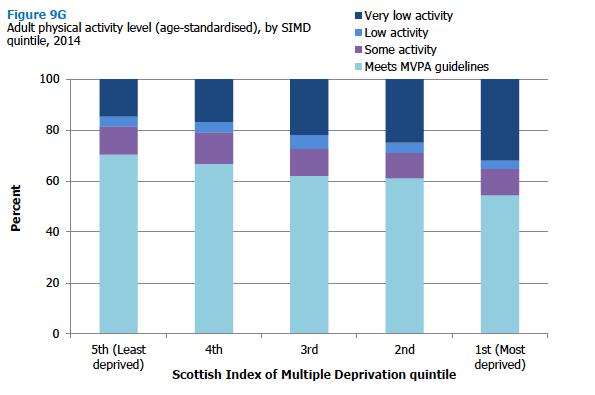
9.7 OVERWEIGHT AND OBESITY
9.7.1 Adults
Considering 2003 to 2014 overall, there was a significant association between SIMD and the prevalence of men who were overweight and obese (BMI 25 kg/m2 and over). The patterns in each year were not wholly consistent, but overweight / obesity was generally significantly higher for those living in the least deprived quintile compared with those living in the most deprived quintile. The pattern was reversed among women, and was much clearer with overweight / obesity significantly higher among those living in more deprived areas than the least. There were no significant changes over time, and so it remains the case that just over half of women in the least deprived areas are overweight or obese compared with almost two-thirds of those in the most.
Obesity (BMI 30 kg/m2 and over) prevalence was significantly higher among those living in more deprived areas compared with those living in less deprived areas during 2003 to 2014; this was the case among both men and women (though absolute differences were generally larger for women). There was a significant increase between 2003 and 2008 in obesity among men but not women, but the social patterning did not change over time.
The patterns described above were also evident among adults with BMI of 40 kg/m2 and over; prevalence was higher among those living in more deprived areas compared with those living in less deprived areas during 2003 to 2014. The social patterning of BMI 40 kg/m2 and over has not changed over time.
Mean BMI was significantly higher among those living in more deprived areas compared with those living in less deprived areas during 2003 to 2014; this was the case among both men and women. There was a significant increase over time in mean BMI among men across the whole population, but not women, and the patterning of social inequalities in mean BMI has not changed. Table 9.11
9.7.2 Children
There was a significant association between SIMD and the proportion of children aged 2-15 with a weight within the healthy range in the 1998-2014 period. For the majority of years, children living in the least deprived quintiles were the most likely to have a healthy weight, with those living in the two most deprived quintiles typically the least likely to do so. Across the whole population, there was no significant variation over time in the proportions with weight within the healthy range. However, the association between SIMD and healthy weight has varied significantly over time, with the pattern described above generally becoming more evident from 2009 onwards.
Table 9.12 presents the proportions of children at risk of overweight (BMI at or above the 85th percentile but below the 95th percentile) and those at risk of obesity (BMI at or above the 95th centile). These two sets of figures illustrate how the pattern described above for healthy weight is largely accounted for by the social patterning in prevalence of obesity risk. Being at risk of overweight (but not obese) was not associated with area deprivation, with figures very similar across the quintiles in most years. In contrast, in every year, children living in the least deprived areas had the lowest levels of obesity risk (BMI at or above the 95th centile) and, from 2009 onwards, those in the most or 2nd most deprived areas had the highest risk. While overall levels of overweight or obesity did not vary significantly over time, the association between SIMD and risk of obesity did, as Figure 9H illustrates. Figure 9H, Table 9.12
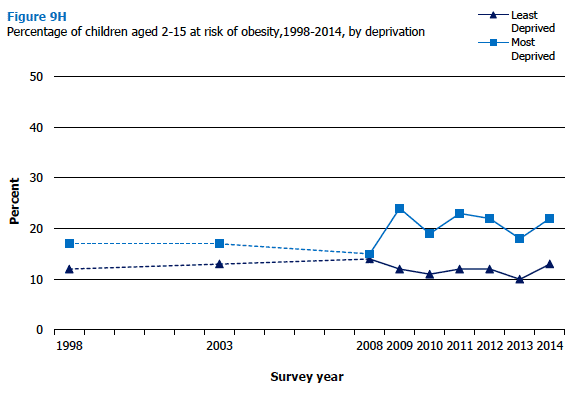
Contact
Email: Julie Landsberg
There is a problem
Thanks for your feedback